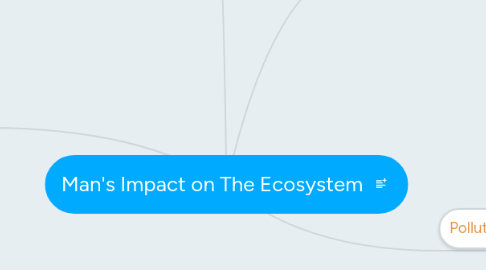
1. Uncontrolled fishing practices
1.1. Over-fishing
1.1.1. some species of fish caught in large numbers that their population have drastically decreased.
1.2. Drift nets
1.2.1. nets that are left to drift freely in seas, trap almost everything in their path.
1.3. Trawlers
1.3.1. drag large fishing nets along the seabed, trapping marine life indiscriminately.
1.4. Dredges
1.4.1. scrape the seabed, destroying coral reefs and organisms that live on the seabed.
1.5. Cyanide fishing
1.5.1. to catch fish for pets, cyanide (poisonous) is squirted into the water around coral reefs. The cyanide stuns reef fish and makes them unable to swim properly.
2. Inorganic wastes
2.1. Insecticides
2.1.1. destroy crop plants and transmit diseases
2.1.2. becomes ineffective after some time. Insects pass the favourable genes to their offspring and over time, the population of insects rises
2.1.3. end up affecting organisms other than insects. insecticides carried by rainwater into streams, rivers and lakes, accumulation high concentrations in the bodies of aquatic organisms
2.2. Poisonous metals (eg mercury, zinc, lead)
3. Deforestation
3.1. Flooding
3.1.1. eroded soil may be deposited in rivers and streams, blocking the flow of water. Water level rises rapidly as a result.
3.2. Soil erosion
3.2.1. soil is directly exposed ti the force of the rain and there also no roots to bind to the soil. The top soil (most fertile layer) is eroded.
3.3. Climate changes
3.3.1. trees are cleared means less trees, hence fewer clouds,therefore less transpiration and rainfall. The area becomes dry and warm. Annual rainfall decreases.
3.4. Desertification
3.4.1. leafy canopy of trees no longer exist, sunlight falls directly into soil. Water evaporates rapidly from the soil, causing it to harden. Land becomes barren and plants cannot grow in the soil.
4. Pollution
4.1. Eutrophication
4.1.1. too many nutrients like nitrogen and phosphorous are present in lakes, stream and river. Algae, plankton, and other microorganisms love these types of nutrients and would feed on them, hence increasing their numbers. They block light entering the water and prevent the aquatic plants from photosynthesizing, a process which provides oxygen in the water to animals that need it, like fish and crabs

